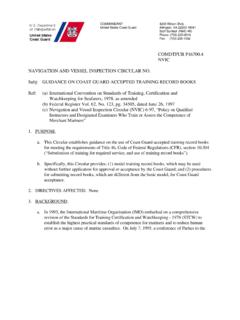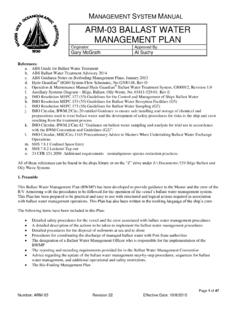Transcription of IMO - Pacific Pilotage Authority Canada
1 INTERNATIONAL MARITIME ORGANIZATION. E. IMO. ASSEMBLY A 2 21st session 4 February 2000. Agenda item 9 Original: ENGLISH. RESOLUTION (21). adopted on 25 November 1999. guidelines FOR VOYAGE PLANNING. THE ASSEMBLY, RECALLING Article 15(j) of the Convention on the International Maritime Organization concerning the functions of the Assembly in relation to regulations and guidelines concerning maritime safety and the prevention and control of marine pollution from ships, RECALLING ALSO section A-VIII/2, Part 2 (Voyage planning) of the Seafarers' Training, Certification and Watchkeeping Code, RECALLING FURTHER the essential requirements contained in the International Convention on Standards of Training, Certification and Watchkeeping for Seafarers and the International Convention for the Safety of Life at Sea concerning voyage planning, including those relating to officers and crew, shipborne equipment, and safety management systems, RECOGNIZING the essential importance for safety of life at sea, safety of navigation and protection of the marine environment of a well planned voyage.
2 And therefore the need to update the 1978 Guidance on voyage planning issued as , NOTING the request of the Assembly in resolution (19) that the Maritime Safety Committee consider the issue of voyage planning in conjunction with its review of the Code for the Safe Carriage of Irradiated Nuclear Fuel, Plutonium and High-Level Radioactive Wastes in Flasks on Board Ships (INF Code), and the Committee's decision that consideration of the issue of voyage planning should not be restricted to vessels carrying materials subject to the INF Code but should apply to all ships engaged on international voyages, HAVING CONSIDERED the recommendation made by the Sub-Committee on Safety of Navigation at its forty-fifth session: 1.
3 ADOPTS the guidelines for voyage planning set out in the Annex to the present resolution;. 2. INVITES Governments to bring the annexed guidelines to the attention of masters of vessels flying their countries' flag, shipowners, ship operators, shipping companies, maritime pilots, training institutions and all other parties concerned, for information and action as appropriate;. 3. REQUESTS the Maritime Safety Committee to keep the said guidelines under review and to amend them as appropriate. For reasons of economy, this document is printed in a limited number. Delegates are kindly asked to bring their copies to meetings and not to request additional copies.
4 I:\ASSEMBLY\21\Res\ A 2 - 2- ANNEX. DRAFT guidelines FOR VOYAGE PLANNING. 1 Objectives The development of a plan for voyage or passage, as well as the close and continuous monitoring of the vessel's progress and position during the execution of such a plan, are of essential importance for safety of life at sea, safety and efficiency of navigation and protection of the marine environment. The need for voyage and passage planning applies to all vessels. There are several factors that may impede the safe navigation of all vessels and additional factors that may impede the navigation of large vessels or vessels carrying hazardous cargoes.
5 These factors will need to be taken into account in the preparation of the plan and in the subsequent monitoring of the execution of the plan. Voyage and passage planning includes appraisal, gathering all information relevant to the contemplated voyage or passage; detailed planning of the whole voyage or passage from berth to berth, including those areas necessitating the presence of a pilot; execution of the plan; and the monitoring of the progress of the vessel in the implementation of the plan. These components of voyage/passage planning are analysed below. 2 Appraisal All information relevant to the contemplated voyage or passage should be considered.
6 The following items should be taken into account in voyage and passage planning: .1 the condition and state of the vessel, its stability, and its equipment; any operational limitations; its permissible draught at sea in fairways and in ports; its manoeuvring data, including any restrictions;..2 any special characteristics of the cargo (especially if hazardous), and its distribution, stowage and securing on board the vessel;..3 the provision of a competent and well-rested crew to undertake the voyage or passage;..4 requirements for up-to-date certificates and documents concerning the vessel, its equipment, crew, passengers or cargo.
7 5 appropriate scale, accurate and up-to-date charts to be used for the intended voyage or passage, as well as any relevant permanent or temporary notices to mariners and existing radio navigational warnings;..6 accurate and up-to-date sailing directions, lists of lights and lists of radio aids to navigation; and .7 any relevant up-to-date additional information, including: .1 mariners' routeing guides and passage planning charts, published by competent authorities;. I:\ASSEMBLY\21\Res\ - 3- A 2 .2 current and tidal atlases and tide tables;..3 climatological, hydrographical, and oceanographic data as well as other appropriate meteorological information.
8 4 availability of services for weather routeing (such as that contained in Volume D of the World Meteorological Organization's Publication No. 9);..5 existing ships' routeing and reporting systems, vessel traffic services, and marine environmental protection measures;..6 volume of traffic likely to be encountered throughout the voyage or passage;..7 if a pilot is to be used, information relating to Pilotage and embarkation and disembarkation including the exchange of information between master and pilot;..8 available port information, including information pertaining to the availability of shore-based emergency response arrangements and equipment; and.
9 9 any additional items pertinent to the type of the vessel or its cargo, the particular areas the vessel will traverse, and the type of voyage or passage to be undertaken. On the basis of the above information, an overall appraisal of the intended voyage or passage should be made. This appraisal should provide a clear indication of all areas of danger; those areas where it will be possible to navigate safely, including any existing routeing or reporting systems and vessel traffic services; and any areas where marine environmental protection considerations apply. 3 Planning On the basis of the fullest possible appraisal, a detailed voyage or passage plan should be prepared which should cover the entire voyage or passage from berth to berth, including those areas where the services of a pilot will be used.
10 The detailed voyage or passage plan should include the following factors: .1 the plotting of the intended route or track of the voyage or passage on appropriate scale charts: the true direction of the planned route or track should be indicated, as well as all areas of danger, existing ships' routeing and reporting systems, vessel traffic services, and any areas where marine environmental protection considerations apply;..2 the main elements to ensure safety of life at sea, safety and efficiency of navigation, and protection of the marine environment during the intended voyage or passage;. such elements should include, but not be limited to.





